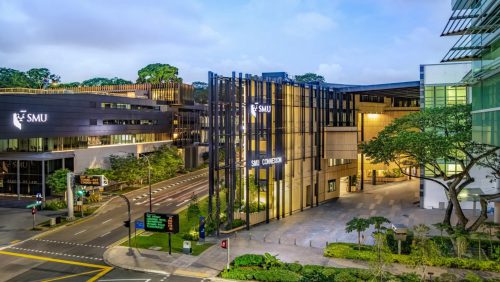
Fronted by SMU’s innovation team and academic researchers, the project aims to achieve Net Zero Energy (NZE) performance by applying a range of innovative technologies on air-conditioning, lighting, building control system, smart technologies.
The design thought process behind SMU’s Tahir Foundation Connexion (TFC) building and elaborated on its key design features and initiatives which upon completion in 2019 will be the first Green Mark Platinum and on-site net zero energy building in the city centre. The five-storey on-site net zero energy building is designed to support the university’s innovative SMU-X experiential learning framework, as well as cultivate innovation and entrepreneurship. It will add over 8,600 sqm of teaching-and-learning space to SMU’s city campus. TFC was built using mass engineered timber (MET), employ solar panels to produce green energy and various smart control systems and sensors for building to efficiently operate at optimum energy levels. It will meet the WELL standard and be a super low energy building (SLE). With an estimated energy use intensity (EUI) of 58.6kWh/sqm/year, it is 45% more efficient than the Green Mark Platinum standard.
The project employs a range of strategies to optimize energy performance, including:
• Enhanced Building Envelope: A high-performance building envelope reduces heat transfer and enhances insulation, contributing to overall energy efficiency.
• Photovoltaic Array: Comprehensive photovoltaic arrays harness solar energy to generate electricity, offsetting conventional energy consumption and moving towards self-sufficiency.
• Passive Displacement Cooling: Innovative passive displacement cooling systems minimize energy usage for air conditioning while improving indoor comfort and air quality.
• LED Lighting and Smart Control: Energy-efficient LED lighting combined with smart controls ensures optimal lighting levels based on occupancy, further reducing energy consumption.
• Plug Load Management: Intelligent plug load management systems monitor and regulate energy usage, optimizing efficiency without compromising functionality.
• Operation-Centric Smart Control System: Advanced control systems optimize building operations for maximum energy efficiency, enhancing overall performance and sustainability.
• Converged Power System: Conventional UPS systems are replaced with converged power systems, reducing energy consumption, maintenance costs, and heat generation.
• Oil-Free Chiller: Oil-free chiller technology significantly reduces energy consumption for cooling, contributing to overall energy savings.
• IAQ Monitoring and Ventilation Control: Occupancy-responsive ventilation systems maintain indoor air quality while minimizing energy usage, ensuring a healthy and sustainable indoor environment.